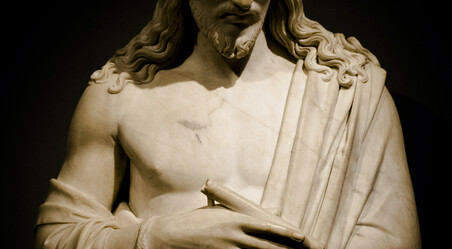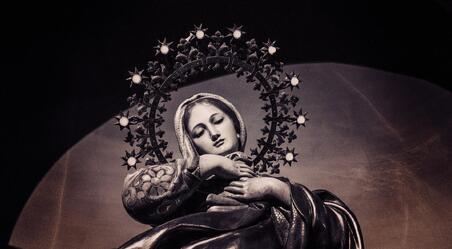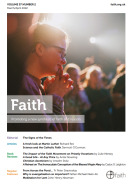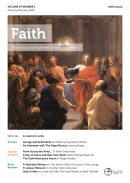Featured
Christ and His Bride: Male and Female
Whether it is fashionable to say so or not, the reality of the human race as male and female is central.
The Divine Exchange
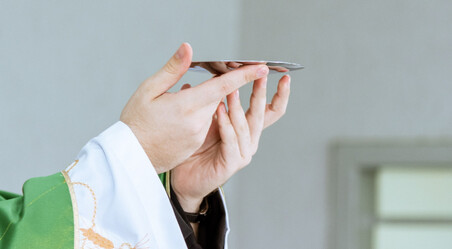
Sister Claire Waddelove looks at the mystery of the Incarnation
The Neglect of Freedom and the Persecution of the Church
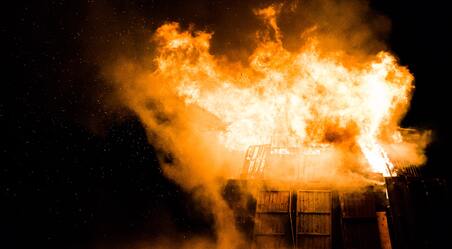
Mgr Michael Nazir-Ali examines the traditions of religious tolerance and their neglect, as well as possible ways forward in assisting those being persecuted.
Holloway on?

In this second half of an article published in FAITH in November 1992, Fr Holloway is addressing seminarians and young priests.
Trying to help preachers

The Art of Preaching - A Theological and Practical Primer by Daniel Cardo, Catholic
University of America Press, 224pp, £31.95.
Dante Reinterpreted

Dante’s Divine Comedy: A Guide for the Spiritual Journey by Mark Vernon, Angelico Press, 466pp,
hardback £24.50, Kindle £6.54.
A reviled but faithful Jesuit

Jesuit at Large: Essays and Reviews by Paul V. Mankowski SJ, Ignatius Press, 197pp,
£12.59.
-
Christ and His Bride: Male and Female
Whether it is fashionable to say so or not, the reality of the human race as male and female is central. It is not merely something we understand about ourselves – there has always, in every culture, been a recognition that it has some spiritual significance, too.
For Christians, this recognition is a rich and liberating one. In the 21 st century, we are beginning to understand it anew. The current anguish in the West, with its talk of “many genders” and its families struggling to make sense of teenagers with “gender identity” is, in its own bleak way, going to play its part in that understanding.
The Church is the Bride of Christ. The New Testament has many references to Christ as the Bridegroom. “Can the wedding guests mourn as long as the bridegroom is with them?” Christ asks his disciples in Matthew 9:15. Christ’s first miracle is at a wedding, at Cana in Galilee (John 2:1-12) where, significantly, the names of the bride and bridegroom are not given, thus establishing that with the miracle something much more is happening than the mere provision of good wine for a feast.
This image of the Church as Bride is celebrated in the nuptial language used in the liturgy and in hymns and prayers. Protestant as well as Catholic hymns use it: “From heaven he came and sought her/to be his holy bride;/with his own blood he bought her,/and for her life he died.”
Christ and his Church
The Catechism of the Catholic Church notes that the Church is both “a hierarchical society and the Mystical Body of Christ. This is her mystery, which only faith can accept.”(779) But it is not a mystery in the sense of being something utterly impossible to explore or discuss or study. Rather “The comparison of the Church with the body casts light on the intimate bond between Christ and his Church. Not only is she gathered around him, she is united in him, in his body” (CCC 789, emphasis original). Because of this understanding of the Church as the Body of Christ, all of her members share a unity with one another. And Christ is the head of
the Body.Pope Benedict XVI liked to quote Romano Guardini, the noted theologian of the first half of the 20 th century, who coined an expression that was much quoted in Germany in the years after the First World War when much debate was taking place about ecclesiology and Christian doctrine: “Something of great importance is happening: the Church is awakening in people’s souls.” It was this “awakening” which would find a voice in Pope Pius XIII’s encyclical Mystici Corporis, and also in the ecclesiology of the Second Vatican Council. Ratzinger (now Pope Emeriutus Benedict XVI) writes: “Whereas until then [i.e. the 1920s] we had thought of the Church primarily as a structure or organisation, now it dawned on Catholics: we ourselves are the Church. The Church is much more than a structure or an organisation it is the organism of the Holy Spirit, something that is alive, that takes hold of our inmost being. This consciousness found verbal expression with the concept of the “Mystical Body of Christ”, a phrase describing a new and liberating experience of the Church.” (Ecumenism and Politics, p. 13)
As Philip Trower notes: “To the outward eye, the Church on earth looks much like other organised bodies of people with rulers, laws, institutions and customary practices. That is how the world sees her. And as far as it goes, the world is right. God meant the Church to be like that. Indeed, in her own realm, according to an age-old definition, the Church is ‘a perfect society’: that is, she has everything in herself necessary for her life and mission; she has recognizable boundaries; she is not dependent on any other society (she is not, for instance, as so many emperors, kings and statesmen have tried to make her, a department of state)” (Philip Trower, Turmoil and Truth, p. 75)
But as Trower also notes, too much emphasis on the organisation leads to a veiling of what is heavenly by what is earthly, and to the faithful identifying the Church mainly with her rulers.
In the early 19 th century, Johann Adam Mohler (1796-1838) began to offer a richer and more integrated vision of the Church, emphasising the idea of communion. He saw the Church’s visible unity and structures as crucial and necessary, but only part of the greater reality: The Church is the corporate life brought about by Jesus; its origins must be grasped historically and dynamically. Its foundation lies in a religious intimacy between Jesus and his followers that grows organically through the spread of like relationships. Mohler’s ecclesiology would have a powerful impact on 19 th and 20 th century theology, and thus on the Second Vatican Council. It marched with John Henry Newman’s writings on the Church, and both drew heavily on the rediscovery of the importance of the Church Fathers, moving gently away from the over-emphasis on counter-Reformation theology and ecclesiology which had marked the previous two centuries.Mohler’s ecclesiology influenced a theologian who was a peritus at the Second Vatican Council, Joseph Ratzinger, who would later write: “J.A. Möhler, a leader in the revival of Catholic theology after the devastation of the Enlightenment, once said: a certain erroneous theology could be caricatured with the short phrase: ‘In the beginning Christ created the hierarchy and had thus taken adequate care of the Church until the end of time’. We must contrast this, he said, with the truth that the Church is a Mystical Body, that is, Christ himself founds her anew again and again; that he is never merely her past, but he is always and above all her present and future. The Church is the presence of Christ: He is contemporary with us and we are His contemporaries. The Church lives from this fact: that Christ is present in our hearts and it is there that Christ forms His Church and not vice versa” (Ecumenism and Politics, p. 14)
Pius XII in Mystici Corporis writes of the reality of this in the lives of Catholic lay people, and in doing so begins to open up the teaching on the role of the laity which will be much further developed during and after the Second Vatican Council some two decades later.
The Bride of Christ
Scriptural imagery of the Church as the Bride of Christ begins in the Old Testament, with the covenant bond between God and Israel.
The bond between God and his people in the Old Covenant leads to the bond between Christ and the Church in the New. Christ’s first miracle is at a wedding, at Cana. Here, he turns water into wine (John 2:1-12), after Mary has told the servants “Do whatever he tells you”.He tells Mary that his “hour” (i.e. the time of his Passion, Death, and Resurrection) has not yet come, but at the same time he anticipates it, draws us into it. At the Last Supper, we hear the word “do” again as Christ takes wine and says, “Do this in memory of me” (Luke 22:20). There is a nuptial imagery, going back to Cana and beyond to the covenant bond of the Old Testament, in every Mass. The union between Christ and his Bride the Church is celebrated in this way at every Mass, that union which was consummated on Calvary.
The cup at the Last Supper is “the new covenant in my blood” (Luke 22:23) and in the Eucharist we also look ahead to the final culmination of all things at the “marriage feast of the lamb” in Heaven (Rev 19-7-10).
Benedict XVI writes “The superabundance of Cana is therefore a sign that God’s feast with humanity, his self-giving for men, has begun. The framework of the event, the wedding, thus becomes an image that points beyond itself to the messianic hour: The hour of God’s marriage feast with his people has begun in the coming of Jesus. The promise of the last days enters into the Now” (Jesus of Nazareth [Vol 1], p. 252)
The Gospels make many references to Christ as the Bridegroom. He asks his disciples in Mark 2:19 and in Luke 5:34 “Can the wedding guests fast when the bridegroom is with them?”. In the letter to the Ephesians (5:22-33) St Paul specifically compares the union of a man and a woman to that of Christ and his Bride, the Church. Benedict XVI notes that in Mark 2:19 Jesus “identifies himself here as the ‘bridegroom’ of God’s promised marriage with his people...In him, in an unexpected way, God and man becomes one, become a ‘marriage’” (Jesus of Nazareth [Vol 1], p. 252)
Marriage: union of male and female
The cup at the Last Supper is “the new covenant in my blood” (Luke 22:23) and in the Eucharist we also look ahead to the final culmination of all things at the “marriage feast of the lamb” in Heaven (Rev 19-7-10).
At the beginning of the Old Testament, in Genesis, we learn that “the man shall leave his father and mother and cleave to the woman and they shall become one flesh” (Gen 2:24). Ratzinger notes the implication that this is a single new existence. Paul also takes up this idea that man and woman become one flesh in a bond at once spiritual and physical in the First Letter to the Corinthians, where he states that this word is fulfilled in communion ‘He who cleaves to the Lord becomes one spirit with him’ (1 Cor 6:17).
God’s whole covenant plan is nuptial, and in this plan the Eucharist is central: it is the marriage feast of Christ and his Bride. The Bride is fruitful - she becomes a mother, which is why we refer to the Church as Our Holy Mother the Church.
In all of this, Mary is central. Henri de Lubac argues that in the Church’s tradition the same symbols are applied, either in turn or simultaneously, with one and the same ever-increasing profusion, to the Church and Our Lady. He lists a great multitude of such symbols, with many a footnote to show that he is not alone is making these links and that they are attested by Origen, Augustine, St Bernard, St Methodius of Olympus, St John Damascene and innumerable others. The Scriptural images he lists that apply to both Mary and the Church include the Ark of the Covenant, the Gate of Heaven, the City of God, the Bride arrayed for her husband, the valiant woman of Proverbs, and the woman clothed with the sun and victorious over the dragon as described in Revelation.
Ratzinger argues that Mary signifies that in herself Old and New Covenants are really one. She is entirely a Jewess, a child of Israel, of the Old Covenant, and as such a child of the full covenant, entirely a Christian: Mother of the Word. She is the New Covenant in the Old Covenant, she is the New Covenant as the Old Covenant.Mary’s “yes” at the Annunciation, her “fiat”, her active response to God, symbolises and begins the Church’s active response, the Church’s “yes” to God. The Church is not passive. A Bride is not passive. There is a co-operation between God and his people, between Christ and his Church. Henri de Lubac writes that Catholic faith regarding Our Lady sums up symbolically, in its special case, the doctrine of human co-operation in the Redemption and thus provides the synthesis, or matrix concept, as it were, of the dogma of the Church.
Synthesis
A synthesis between the Church as “body” and as “bride” is achievable precisely because in a marriage the “two become one flesh”. The Bridegroom and the Bride form, as it were, one body. They are no longer two, but one, and that one-ness is even expressed through their flesh, through their bodies. The unity between man and wife is such that, as Scott Hahn memorably puts it ‘they become so one that nine months later you might just have to give it a name.’
The Church as the Body, and the Church as the Bride are not opposites, they are not even merely complementary: they actually fit together and form a unity and an integrity that makes for a vision of wholeness.
This wholeness is also exemplified in the Eucharist. Here, we who are members of the Church, members of the Body, (I Cor 12:12) partake of Christ’s body. We “receive what we are”. We are fully united with him. As the traditional prayer of thanksgiving after Communion expresses it: ‘Soul of Christ sanctify me/Body of Christ save me...Within your wounds hide me/Never permit me to be parted from you.’
The wholeness is also understood when we grasp the significance of Mary. This is something that was dramatically pressed forward at the Second Vatican Council, when the teaching on the role of Mary was placed not in a separate document but in the one on the Church, Lumen Gentium.
It caused considerable debate and controversy at the time, but the whole idea of a “Marian understanding” of the Church continues to reverberate and bear fruit. It is something that was pressed strongly by Blessed John Paul, who in a striking Christmas address to the Roman Curia in December 1987, borrowing from the Swiss theologian Hans Urs von Balthasar, suggested to some shocked senior churchmen that the ‘Marian profile’ in the Church was prior to, and made sense of, the Church’s “Petrine profile.”
And as Mary fulfils, as Henri de Lubac noted in a passage already cited, the rich prophetic images of the Old Testament (the Ark of the Covenant, the woman of Proverbs, and so on), so she is the ultimate Bride and the ultimate Mother. In an Introduction to his book The Splendour of the Church, de Lubac says that “the Church’s children can boldly borrow the words of the Bridegroom in the Song of Songs...and say to their Mother, with a depth born of ever-increasing conviction ‘Thy voice is sweet and thy face is beautiful’ (The Splendour of the Church, p. 13).


